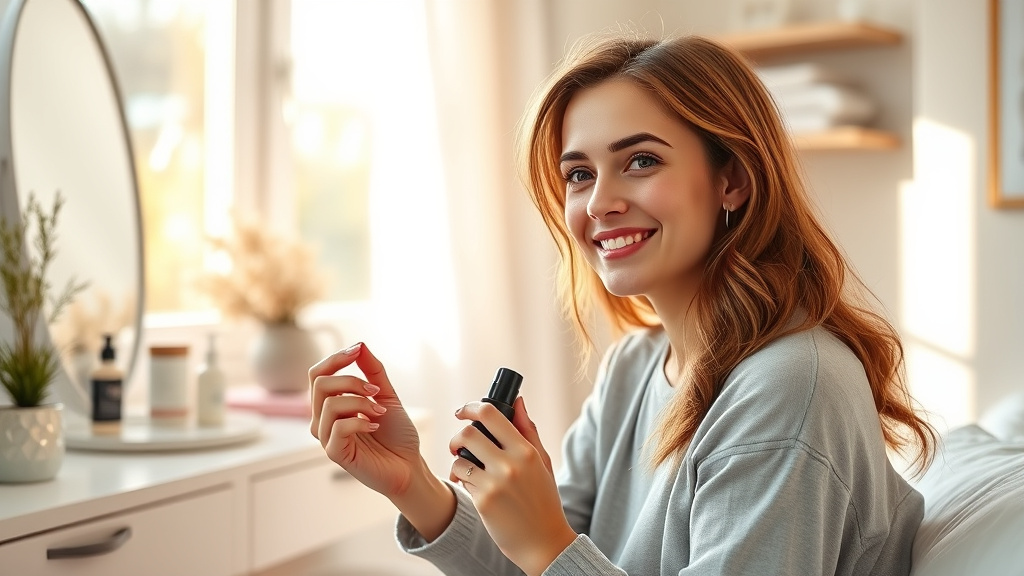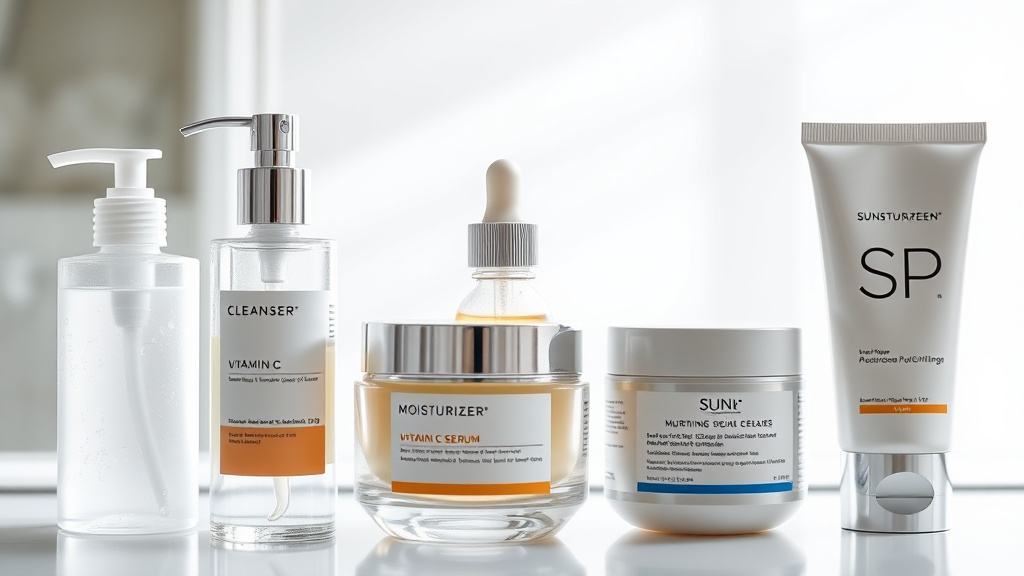When starting your skincare journey, understanding the skincare routine order can feel overwhelming. You might wonder which product to apply first, how to layer them properly, or how to avoid damaging your skin barrier. The truth is, mastering the layering skincare products in the correct sequence makes a big difference in how well the ingredients work and how your skin feels. A well-structured routine—whether morning skincare routine or evening skincare routine—can enhance your skin’s health, help prevent issues like hyperpigmentation, and support your skin barrier.
In this comprehensive guide, we’ll explore the skincare routine order that works for beginners, focusing on key ingredients like antioxidants, niacinamide, and retinol, and highlighting crucial steps like sunscreen reapplication. By understanding the logic behind product layering and following a simple, effective routine, you can take confident steps toward healthier, more balanced skin.
Introduction: Why Skincare Routine Order Matters

The skincare routine order is more than just a sequence—it’s about maximizing ingredient synergy and protecting your skin. Applying products in the wrong order can reduce their effectiveness, cause irritation, or even damage your skin barrier. Think of your skin as a sponge; if you apply heavy oils or ointments first, lighter serums may sit on top and not penetrate properly. Conversely, applying a thick moisturizer before a serum can prevent active ingredients from reaching their target.
For beginners, understanding the layering skincare products correctly helps build healthy habits and prevents common mistakes like overloading the skin or skipping essential steps like sunscreen. Proper sequencing ensures your skin absorbs the benefits of each product while maintaining the integrity of your natural skin barrier, which is crucial for overall skin health and preventing concerns like hyperpigmentation and redness.
Why Skincare Routine Order Matters
The skincare routine order is especially important for layered products such as antioxidants, acids, and moisturizers. When ingredients are applied in the right sequence, they work more effectively—like a well-curated team working towards a common goal. For example, applying a vitamin C serum before moisturizer can optimize antioxidant protection, whereas using retinol after hydrating serums can help reduce irritation.
Furthermore, correct layering can support your skin barrier, which acts as the first line of defense against environmental stressors and irritants. A compromised barrier may lead to dryness, redness, or increased sensitivity, making routine order crucial for sensitive or dry skin types. For many beginners, learning this sequencing forms the backbone of a simple, affordable, yet highly effective routine that promotes healthy skin for the long term.
Niacinamide, also known as Vitamin B3, is widely studied for its calming and barrier-supporting benefits.
According to Healthline’s guide on Niacinamide, it can also help reduce inflammation, minimize redness, and improve overall skin texture.
Morning Routine (AM)
A morning skincare routine should prepare your skin for the day, protect against environmental damage, and minimize the risk of breakouts. The key steps involve cleansing, applying brightening and antioxidant treatments, moisturizing, and finally, sunscreen for protection.
1. Cleanser
Start with a gentle gel cleanser to remove excess oil and impurities accumulated overnight without stripping your skin’s natural oils. This prepares your skin for the subsequent layers and ensures better absorption of active ingredients.
2. Treatment (Vitamin C / Niacinamide)
Next, incorporate antioxidant serums such as vitamin C or niacinamide. These ingredients may help brighten your skin, support collagen production, and protect against free radicals. For example, niacinamide can support a healthy skin barrier and reduce visible pores, making it a common staple in beginner skincare guides.
3. Moisturizer
Apply a lightweight gel moisturizer suitable for your skin type to hydrate and lock in the active treatments. Opt for formulations containing ingredients like hyaluronic acid, which supports hydration without feeling heavy.
4. Sunscreen (SPF 30–50)
Finally, finish with a broad-spectrum sunscreen to shield your skin from UV rays. Reapplying sunscreen every 2 hours when exposed to sunlight is essential, especially if you’re outdoors or near windows.
Evening Routine (PM)

The evening skincare routine focuses on repairing, nourishing, and strengthening your skin after a day of exposure. It typically involves thorough cleansing, active treatments like retinoids or acids, hydrating serums, and moisturizers that support skin repair.
1. Double Cleanse
Start with an oil-based cleanser or micellar water to dissolve makeup and SPF, followed by a gentle gel cleanser to remove residual impurities without disrupting your skin barrier. This double cleanse approach is recommended in skincare routines for all skin types, especially those with sensitive or dry skin.
2. Treatment (Retinoids / Acids)
Next, apply targeted actives like retinoids, AHAs, or BHAs. Retinoids (including retinol) can support skin renewal and mitigate hyperpigmentation, but they are best introduced gradually and used sparingly. Remember, retinol may cause dryness or irritation initially, so starting with a low percentage (around 0.25–0.5%) helps your skin adapt.
Meanwhile, acids like AHA (glycolic acid) or BHA (salicylic acid) exfoliate dead skin cells, leading to a smoother texture and clearer pores. Use acids 2-3 times a week to avoid over-exfoliation that can harm your skin barrier.
3. Hydration (Serum)
Apply a nourishing serum containing hyaluronic acid or other humectants to replenish moisture and soothe any irritation from active treatments. Hydrating serums help maintain skin elasticity and softness.
4. Moisturizer
Finish with a richer moisturizer or barrier-restoring cream, especially if you have dry or sensitive skin. Ingredients like ceramides and azelaic acid (which can also support reduced redness and hyperpigmentation) reinforce your protective skin barrier overnight.
Common Mistakes in Skincare Order
Even the most enthusiastic beginners can stumble into common pitfalls with skincare layering. One frequent mistake is applying retinol immediately after cleansing without waiting for earlier layers to absorb, which can cause irritation. Similarly, skipping sunscreen during the day or forgetfulness to reapply leaves the skin vulnerable to UV damage, counteracting some of your best efforts.
Another error is overloading products or using incompatible ingredients together—like combining acids and retinoids without proper spacing can increase sensitivity and damage your skin barrier. Remember, simplicity and patience are the pillars of a successful routine.
FAQs
Q1: Can I layer niacinamide with vitamin C? Yes! These ingredients can be used together and may even enhance each other’s effectiveness when layered properly. For example, applying niacinamide after vitamin C can support skin barrier function.
Q2: How often should I exfoliate with acids? Typically, 2-3 times a week is enough. Over-exfoliating can strip away your skin’s natural oils and harm the skin barrier, especially if you have sensitive skin.
Q3: When should I start using retinol? Begin with a gentle retinol at low concentrations once your skin has adjusted to basic skincare. Always apply it after hydrating serums and before moisturizer at night.
Q4: Do I really need to reapply sunscreen? Yes! Reapplying every two hours helps maintain protection, especially if you are outdoors or near reflective surfaces like water or snow.
Conclusion
Understanding the skincare routine order is fundamental for every beginner who wants to nurture their skin effectively. A well-layered routine ensures that active ingredients are delivered properly, your skin barrier stays healthy, and concerns like hyperpigmentation or redness are well managed. Whether it’s your morning skincare routine or evening skincare routine, adopting proper sequencing—starting with cleansing, applying potent treatments, and finishing with moisturizers and sunscreens—sets the foundation for radiant, resilient skin. Over time, grasping these principles can transform your skincare regimen from confusing to confidently effective, helping you achieve your skin goals gently and sustainably.
Not medical advice. Always patch-test new products and consult a dermatologist for personalized skin concerns.
Want to learn more about skincare routine order and layering? Explore our full Skincare Ingredients Hub for expert guides and routines.



